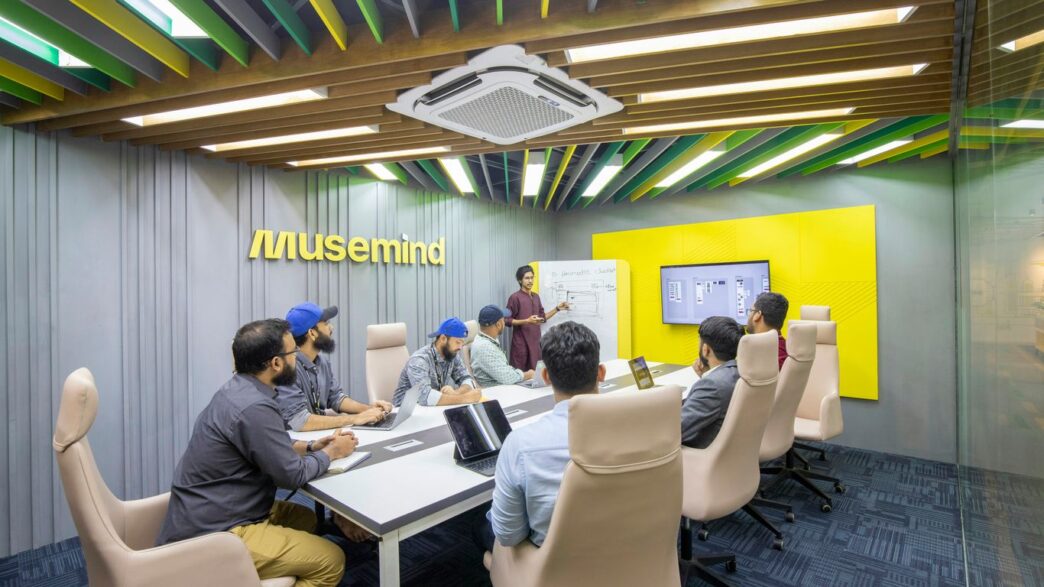AI startups news is everywhere right now, and honestly, it feels like things are moving faster than ever. Just a couple of years back, AI tools were mostly about chatbots and making pictures, but now they’re in almost every corner of business and life. In 2025, companies are spending billions on AI, and about 78% of them are already using it in some way. For startups, that means lots of chances to try new ideas—if they can keep up. This article looks at the biggest trends in AI startups for 2025, from new creative tools to smarter hardware and the push for more trust and transparency. Let’s see what’s changing and what’s next.
Key Takeaways
- Generative AI is moving way past just text and images, with startups now building tools for video, audio, and even 3D content—making creative work faster and more accessible.
- More businesses are using autonomous AI agents to handle everyday tasks like sales, logistics, and customer support, but keeping these systems under control and easy to understand is a big focus.
- Edge AI is taking off, with startups building tech that runs directly on devices like wearables and cameras—this means faster results and better privacy for users.
- Healthcare and science are seeing big breakthroughs, as AI startups help with things like drug discovery, personalized medicine, and research, while also dealing with tough rules and ethical questions.
- Trust and transparency are now just as important as flashy features, so startups are working on AI that explains its decisions, checks for bias, and helps companies follow the rules.
Generative AI Platforms Expand Beyond Text and Images

The world of generative AI has grown well past chatbots making text or apps whipping up quick images from prompts. In 2025, startups are pushing the limits, building serious tools for video clips, music, and even full 3D environments—all from a single idea. For founders and creative teams, this is the most exciting (and possibly overwhelming) year yet. Platforms now promise to take anyone from first thought to finished content without ever switching tools. Whether you’re running a small studio or a big brand, things are moving fast.
Next-Generation Tools for Video, Audio, and 3D Creation
A couple of years ago, only researchers dared try AI-generated video or audio. Today, startups like Midjourney are rolling out AI video models the public can use. These tools do more than just stitch together clips—they control motion, style, and transitions, almost like having a film crew in your browser. 2025 is the year when:
- Video models can turn one prompt into animated, editable scenes.
- Music generators spit out royalty-free tracks for games, podcasts, and ads.
- 3D world builders let users make virtual spaces from just a few sentences.
Leading edge platforms now handle customization, human-like voices, or photo-real visuals, meaning small teams can do the work of a full studio from their laptops. More industries are finding use cases, like social media, education, and retail—anywhere you need eye-catching, dynamic content.
End-to-End Platforms for Content Generation
Single-use tools just don’t cut it anymore. Startups are hustling to build all-in-one solutions that:
- Take an idea from draft to finished product—it could be a full video suite, an audiobook platform, or a 3D asset generator.
- Handle revisions, collaboration, and brand safety without needing extra software.
- Make it possible for non-experts to create professional-grade pieces without hiring big teams.
Comparison of Key Capabilities (2025)
| Feature | AI Video Tools | AI Audio Tools | AI 3D Creation |
|---|---|---|---|
| Text-to-Content | Yes | Yes | Yes |
| Real-Time Editing | Limited | Yes | Yes |
| Collaboration | Built-In | Built-In | Some |
| Commercial Quality Output | Yes | Yes | Getting There |
The gap between idea and finished content is shrinking by the month.
How AI Startups Are Shaping Creative Industries
There’s a running debate: is AI a threat or a tool for creatives? So far in 2025, the trend is clear—AI startups are shaking up whole industries, forcing everyone to rethink how creative work happens. You’ll notice:
- Agencies and brands shifting budgets to AI for video ads, product photos, and social content.
- Musicians and filmmakers using AI to generate demos, background tracks, or even entire scenes.
- Fashion and gaming companies building worlds and characters in days instead of months.
There’s still controversy—from questions about real jobs in the industry to arguments about AI-generated representation. But the genie is out of the bottle. As with other breakthrough technologies before it, creative fields will adapt, even if it means a bumpy start. The companies finding smart, ethical ways to use these platforms could end up shaping the next decade of creative work.
Rise of Autonomous AI Agents in Business Operations

The big story in 2025? Autonomous AI agents aren’t just science fiction—they’re rolling up their sleeves in everyday business. From automating tough sales tasks to picking warehouse orders at lightning speed, startups are rethinking what “getting work done” means. These tools aren’t perfect, but in a year where 78% of companies use AI for at least one job, the push for smarter, more hands-off solutions is unmistakable.
Automating Sales, Warehousing, and Logistics
It used to be chatbots answering questions. Now, autonomous AI agents handle much more:
- Sales teams get bots to prospect leads, send follow-ups, and keep CRMs tidy—think fewer missed emails and more closed deals.
- In warehousing, robots pick, pack, and check inventory automatically, driving down costly mistakes.
- Fast food chains experiment with self-driving bots for meal delivery, shrinking wait times and letting staff focus on tougher jobs.
Here’s a quick picture of what’s changing:
| Area | Common Agent Tasks | Main Benefits |
|---|---|---|
| Sales | Outreach, follow-ups, CRM | More leads, fewer errors |
| Warehousing | Stocking, picking, delivery | Lower labor costs |
| Logistics | Route planning, tracking | Faster deliveries |
If you want a peek at how things like no-touch interfaces and even driverless cars fit into this picture, emerging tech like human-like robots is changing daily work beyond the back office.
Startups Building Practical Agents for Everyday Tasks
Forget wild innovation—what actually helps is what matters. Startups are building focused, easy-to-use agents for:
- Booking calls and managing calendars.
- Automatically capturing and summarizing meetings.
- Monitoring supply chains, so managers only get flagged when there’s a real problem.
For founders, the magic is in freeing up people for creative work instead of busywork. Investors love agents that cut mistakes and save time; adoption is rising quickest with small businesses that can’t waste a minute.
Balancing Autonomy, Control, and Transparency
Handing off work to smart software has its risks. Companies are thinking about:
- How much freedom to give their agents before they lose track of what’s happening.
- Ways to review and audit what decisions agents make, especially for sensitive jobs.
- Keeping things transparent, so everyone from workers to regulators knows when a machine (not a person) made a call.
People want AI agents to be helpful, not mysterious. Being able to explain a bot’s choice is already a selling point for new tools. As autonomous AI seeps into every part of business, the next big frontier will be building trust—so that automation feels like a partner, not a black box.
Edge AI Drives Real-Time Intelligence at the Source
This year, we’ve seen a surge in AI moving closer to where the data actually happens—your wrist, your fridge, or that security camera above the door. Edge AI is all about putting smart models in devices people use every day, instead of shipping data off to a distant server. Think fitness trackers spotting heart problems right as they arise, or security cameras watching for break-ins and sending instant alerts. The real kicker? No long waits for the "cloud" to figure things out first. Companies are shipping phones and glasses with built-in AI chips that let you talk to your device, get a translation, or run custom tasks—all offline and all quick.
Here’s what we’re seeing in this space:
- Smart glasses that translate in real time
- Warehouse robots making decisions on the spot
- Industrial sensors flagging issues without an internet connection
Opportunities for Startups in Edge Computing
For scrappy AI startups, Edge computing is the big new playground. There’s less need to worry about massive server bills because much of the work happens right on the device. Startups are:
- Building custom models that trade off size for speed and accuracy.
- Helping retailers track inventory in real time (no lag, no waiting for uploads).
- Designing tools that let factories fix problems as they happen rather than after the fact.
Here’s a snapshot comparing on-device and cloud-based AI in some key tasks:
| Task | Edge AI (On-Device) | Cloud AI |
|---|---|---|
| Face Recognition | Instant (ms) | 1-2 seconds |
| Inventory Counting | Real-time, no delay | 1-5 minute lag |
| Language Translation | Available offline, instant | Must be connected |
Edge startups have an edge (pun intended!)—they can give users that "right now" feeling.
Privacy and Speed as Competitive Advantages
Privacy has become a word folks actually pay attention to. With Edge AI, companies don’t have to send private info—like camera feeds or health stats—to the cloud. This isn’t just a tech perk, it’s a marketing win. When your smartwatch can do its thing without telling some distant server about your sleep patterns, that matters.
Plus, speed. Edge means no more spinning wheels or laggy app experiences. You get your answer, prediction, or alert, right away.
Edge AI’s real strengths are:
- Keeping private info on the device
- Giving instant results (no waiting for the internet)
- Lowering overall costs (less cloud use)
These advantages are making more startups bet on edge over old-school, cloud-only AI. The next year is likely to highlight even more cool edge-powered gadgets, especially from companies nobody heard of even six months ago.
Healthcare and Science Lead Breakthrough AI Adoption
AI in healthcare and science isn’t just about flashy algorithms — it’s showing real results, and the momentum is picking up fast as we head into 2025. We’re seeing smart systems tackling disease detection, helping researchers find new treatments, and raising questions about ethics, all at a nearly breakneck pace.
Precision Medicine and Clinical Applications
Hospitals right now are putting AI to work on personalizing treatments and spotting diseases sooner rather than later. For example, new models can predict the chance of developing cancer using imaging, genetic history, and lab results. Some systems even pick up early-stage lung cancer or indicators of Alzheimer’s from MRI scans — and they do it far quicker than human doctors could on their own.
- AI models recently achieved over 90% accuracy in early cancer detection, according to recent studies.
- Screening tools for diabetic eye disease are going mainstream, making it easier to catch problems before symptoms appear.
- AI helps reduce late-stage diagnoses, which can make treatments less invasive and improve chances for recovery.
Here’s a quick view of what’s happening with AI in precision medicine:
| AI Application | Benefit | Status in 2025 |
|---|---|---|
| Early cancer detection | Higher survival rates | In use across clinics |
| Brain age prediction | Prevents neurodegeneration | Clinical pilot phase |
| Retinal image screening | Prevents diabetic blindness | Rolled out widely |
AI-Powered Drug Discovery and Research Platforms
Startups are jumping on the AI train to speed up drug discovery, something that used to take years or even decades. Now, machine learning models can predict which compounds are likely to work, cutting down guesswork and trial-and-error phases.
- Some drugs designed entirely by AI have entered human trials, fueled by structure-predicting models.
- AI tools are being used to map protein structures more quickly, which shortens development timelines.
- The U.S. government has doubled funding for pediatric cancer projects that rely on AI, showing that this approach isn’t just a fad.
This shift in research is huge — not just for pharmaceutical companies, but also for smaller startups hoping to make their mark.
Startups Meeting Regulatory and Ethical Demands
With all the breakthroughs, regulation isn’t far behind. Many doctors are still uneasy about relying on autonomous systems, especially in fields like diagnostics. Roughly 70% of surveyed physicians report concerns about data bias and a lack of transparency in AI decision-making.
Steps startups are taking:
- Embedding transparency so clinicians understand recommendations, not just blindly trust black-box outputs.
- Setting up more robust patient consent practices, especially for sensitive data and predictive algorithms.
- Working with regulators to align with new ethical and privacy rules — something that’s becoming a bigger focus, as highlighted in technology updates.
AI’s future in healthcare isn’t only about what’s possible; it’s also about earning trust and keeping patient interests front and center.
Transparency and Trust Take Center Stage in AI Development
The AI industry in 2025 isn’t just about smarter algorithms or speedier systems. Trust and transparency have become almost non-negotiable. People and companies want to know how decisions are made, what data is being used, and whether bias or mistakes could be hiding under the hood.
Rise of Explainable AI Solutions
This year, more startups are rolling out explainable AI (XAI) tools that make machine learning decisions easier to understand for regular folks. Boards and buyers aren’t satisfied with black-box responses anymore. They want real explanations—something like, “Here’s why your loan was declined,” or “Here’s what the AI saw in the data.”
- Startups now build interactive dashboards, showing step-by-step reasoning and model confidence levels.
- Customers can challenge or appeal AI results with greater transparency.
- Regulators pay more attention to explainability in fields like healthcare and finance, pushing startups to offer documentation and easy-to-understand outputs.
Addressing Bias and Fairness in Automated Decisions
Nobody wants a system that treats people unfairly. In 2025, startups face pressure to prove their models don’t introduce or amplify bias. New fairness benchmarks and third-party audits have become fairly common now. Some platforms even flag potential issues and suggest fixes on the spot.
Here’s a quick look at new fairness checks becoming industry standard:
| Bias Metric | 2023 Usage (%) | 2025 Usage (%) |
|---|---|---|
| Demographic Parity | 32 | 65 |
| Equalized Odds | 21 | 56 |
| Adversarial Testing | 15 | 46 |
- More startups share fairness reports as part of onboarding new customers.
- There’s growing demand for AI that auto-adjusts to prevent discrimination as new data comes in.
- Some funding deals now require regular third-party fairness audits before closing.
Building Tools for Auditing and Compliance
Compliance is its own beast these days. Between new regulations in the EU, the US, and Asia, startups need tools to keep up or risk heavy fines. Auditing features are now baked into the development process.
A typical compliance toolkit in 2025 includes:
- Data lineage tracking to verify data sources and usage.
- Automated generation of audit logs showing every model change and deployment.
- Integration with enterprise compliance software.
Teams spend less time chasing old emails for audit trails—everything is logged and ready for inspection. It’s not glamorous, but these steps have become a badge of trust for startups trying to win contracts with big companies.
The bottom line? Transparency in AI isn’t some distant ideal anymore. It’s a key business requirement—and startups that treat it seriously are quickly separating themselves from the rest.
Industry-Specific AI Solutions Outpace General-Purpose Tools
A trend that’s hard to miss these days is how quickly industry-specific, or “vertical,” AI startups are pulling ahead of general-purpose AI. Instead of trying to build a model that does everything for everyone, these companies focus on the nuts and bolts of one field at a time. The result? Faster adoption, better results, and happier customers in places that used to resist new tech.
Vertical AI Startups Targeting Healthcare, Retail, and Finance
Vertical AI is popping up everywhere. Some examples:
- Healthcare: AI tools are streamlining clinical admin, automating billing, and helping doctors sort through endless medical notes.
- Retail: There are now systems that can spot when products are out of stock or help with real-time pricing, often without humans touching a tablet.
- Finance: Tools for fraud detection, faster loan processing, or more accurate credit scoring are rolling out and getting picked up by big banks and scrappy fintechs alike.
Here’s a quick snapshot of where startups are most active:
| Industry | AI Use Cases | Early Leaders |
|---|---|---|
| Healthcare | Clinical notes, medical coding, literature review | Abridge, SmarterDx, OpenEvidence |
| Legal | Contract review, legal research, document drafting | EvenUp, Ivo, Legora |
| Retail | Stock tracking, customer support, pricing | Shelfie, Relex, CognitionX |
| Finance | Credit risk, fraud detection, compliance | Experian, Alloy, InscribeAI |
| Education | Grading, tutoring, content creation | MagicSchool, Brisk Teaching |
These startups aren’t just adding generic features—they’re solving long-standing headaches unique to each sector, as covered in Artificial intelligence has emerged as a dominant trend.
Deep Domain Knowledge As Startup Differentiator
General AI can only guess at the ins and outs of every field. By comparison, vertical AI startups are run by people who know the pain points of their industry firsthand or have teamed up with experts who do. This gives them some big advantages:
- They spot small daily problems and automate them, saving hours each week.
- Features don’t just sound good—they actually get used, because they fit real routines.
- Vendors can quickly adapt as regulations or market needs change, especially in fields like health and finance.
It’s not just about having smarter algorithms; it’s about building workflows that actually match what users deal with day to day.
Case Studies of Successful Niche Applications
Let’s look at a few real world stories where vertical AI is already changing the game:
- EvenUp – Cuts legal demand package drafting from hours to minutes for personal injury law firms. That means lawyers spend less time on paperwork and more on cases.
- Abridge – Helps doctors cut down administrative work by transcribing and summarizing patient visits automatically. Guys in scrubs, actually spending time with patients? Imagine that.
- MagicSchool – Teachers use this for lesson plans, grading, and even language feedback, so they can focus on teaching instead of typing up reports late at night.
The main lesson? The more a tool understands the nitty-gritty of your job, the more likely you are to keep using it. Look for this trend to keep growing as other sectors, like insurance and real estate, catch on and start shifting away from generic AI tools.
AI Hardware Innovations Accelerate Startup Growth
More founders and investors are starting to realize: software alone isn’t enough. In 2025, AI-focused startups are making big moves with custom hardware aimed at squeezing more speed, lower energy, and smarter designs from their machine learning systems. Better hardware means new features, lower costs, and products that simply work faster. Here’s a closer look at what’s happening.
Custom Chips and AI Accelerators for Startups
Forget waiting for the big chipmakers to deliver. A new batch of startups is designing their own AI-focused chips—some for data centers, some for tiny devices you wear or carry.
- Custom AI chips tackle specific tasks, like language models or real-time sensor processing, using way less power than off-the-shelf processors.
- Names like B300 GPUs, Jetson Orin NX, and Intel Xeon 6 SoC are showing up in new edge devices and servers. Even Apple redesigned its core chips for tighter AI integration, so every iPhone update now has smarter, on-device features.
- Some startups use their own chips as a competitive wedge: if your product is faster by design, it’s a lot harder for a rival to copy you.
Energy Efficiency and Performance at the Edge
Running large models in the cloud is expensive. That’s why edge AI is hot—moving the work closer to where data is created (like in a factory, car, or smart home).
Quick compare: Edge AI Chips, 2025
| Chip Name | Typical Use | Power Draw | Speed Bonus (vs. 2023) |
|---|---|---|---|
| Grace C1 | Industrial robots | Low | 2.5x |
| Jetson Orin NX | Camera/IoT devices | Ultra-low | 3x |
| Apple Neural Engine | Mobile devices | Very low | 2x |
Low power and high speed matter because:
- You save on energy bills (a big deal for large-scale installations or wearables).
- Devices run longer or don’t overheat.
- Real-time decisions—like identifying a defect on a factory line the moment it happens—actually work as promised.
Startups Creating Integrated Hardware-Software Stacks
What’s interesting now isn’t just building the chip, but building the whole stack: hardware, firmware, and the software that brings it all together.
- Startups save months or years by packaging everything, so you don’t have to juggle a bunch of different suppliers and platforms.
- Integrated stacks mean updates and troubleshooting are faster, with fewer glitches or mismatches.
- Products get specialized, instead of one-size-fits-all: medical imaging, factory automation, even hand-held AI.
Here are a few ways founders are approaching AI hardware in 2025:
- Partnering with manufacturers in the US, Netherlands, Taiwan, or Malaysia for global distribution.
- Designing chips focused on their own product workloads, instead of generic compute.
- Building full AI “boxes”—with custom chips already inside—so customers can just plug in and go.
Of course, hardware is never easy. Mistakes cost real money and fixes can be slow. But the payoff? When it works, you get fast, unique products that your competition just can’t copy overnight.
Investment, Regulation, and Market Forces Redefine AI Startups
Mergers, Acquisitions, and Funding Trends in 2025
Funding in AI startups hasn’t slowed down this year—in fact, it’s picked up pace as investors look for the next big win. Investment-grade borrowing by U.S. tech firms spiked 70% year over year in the first half of 2025 (growing popularity of debt). Founders are seeing fast deals if they can prove their models work in the real world. Still, some companies are even merging or being snapped up before they’re household names.
Here’s a quick summary of what the market looks like:
| Year | Total AI Startup Investment ($B) | M&A Activity (# of Deals) |
|---|---|---|
| 2023 | 52 | 88 |
| 2024 | 68 | 137 |
| 2025 (H1) | 49 | 90 |
A few things come up again and again:
- Big tech wants what startups have, so acquisition is a real exit path.
- Investors hate hype—they want revenue, not just fancy demos.
- Fast-growing companies aren’t always stable. Some grow huge, then vanish.
Navigating Patchwork Regulation and Compliance
No one’s shocked that regulations for AI are all over the place. There’s a mess of old and new rules in healthcare, finance, and even retail—one small mistake, and a startup can grind to a halt. Today, AI companies find themselves:
- Decoding local laws that change week to week.
- Hiring compliance officers early to avoid fines or bad press.
- Building audit logs and controls right into their products.
All of this means founders have to spend as much time with lawyers as with engineers. Being proactive turns a headache into a selling point for customers who care about safety.
Big Tech Competition and Startup Opportunities
Startups used to own the AI spotlight, but now the big players are making moves. In 2025, the competition is steady—incumbents buy up promising startups instead of building in-house. This leads to:
- More mergers, especially in healthcare, logistics, and finance.
- Higher standards from customers who want proven solutions, not slideshows.
- Startups finding smaller, ignored problems that giants miss.
If you’re a founder, here’s what works right now:
- Focus on steady profits, not just flashy growth.
- Build something others can’t copy easily—think specialized systems or strong community.
- Pay close attention to customer feedback to fix real pain points.
So in summary? The money is still there, but everyone’s smarter about where it goes. Rules are messier than ever, and competition has moved from the wild west to a crowded city. For startups ready to prove real value, 2025 is challenging—but full of real shot opportunities.
Conclusion
So, here we are in 2025, and the AI startup scene is honestly wild. Every week, there’s a new tool, a new company, or some headline about a breakthrough. It’s not just hype anymore—AI is baked into how businesses run, and it’s changing everything from healthcare to retail. But it’s not all smooth sailing. Startups have to deal with tough rules, tricky data, and a ton of competition. The ones that seem to do best are those that pick a real problem and solve it in a way that actually makes life easier for people. If you’re thinking about jumping in, now’s a good time, but you’ll need more than just a clever idea. You’ll need to build trust, keep things simple, and be ready to adapt when things shift—because in AI, they always do. The future’s still a bit fuzzy, but one thing’s clear: AI isn’t slowing down, and neither are the folks building with it.
Frequently Asked Questions
What are the biggest trends for AI startups in 2025?
In 2025, AI startups are going beyond just text and images. They’re making tools that can create videos, music, and even 3D worlds from simple ideas. There’s also a big focus on AI agents that can handle tasks like sales, warehouse management, and customer service on their own. Edge AI, which works right on devices instead of the cloud, is getting more popular too. Healthcare and science are leading the way in using AI for things like finding new medicines and personalizing treatments. Trust and transparency are also very important, so startups are making AI easier to understand and audit.
How are AI startups changing creative industries?
AI startups are making it easier for people to create things like videos, music, and even games without needing a lot of technical skills. With new AI tools, someone can write a short description and see it turned into an animated video or a song. These platforms help artists, game makers, and small businesses make content faster and cheaper than before.
What is Edge AI and why does it matter?
Edge AI means running AI directly on devices like smartwatches, cameras, or factory machines instead of sending everything to the cloud. This makes things faster and keeps data private because it doesn’t have to leave the device. For startups, this means they can build products that work in real-time and protect user privacy, which is a big advantage.
Why is transparency important in AI?
Transparency in AI means people can see how decisions are made. This is important because it builds trust. For example, if a bank uses AI to decide on loans, customers want to know why they were approved or denied. Startups are making tools that explain AI decisions, check for bias, and help companies follow rules and laws.
How are AI startups helping healthcare and science?
AI startups are helping doctors find better treatments for patients, making drug discovery faster, and helping scientists solve big problems. For example, AI can look at lots of patient data to find the best medicine for someone, or it can help researchers discover new materials for things like eco-friendly paint. These breakthroughs can save lives and make healthcare more affordable.
What challenges do AI startups face in 2025?
AI startups have to deal with tough competition, tricky regulations, and the need for good data. Finding skilled workers is hard, and it’s not easy to get funding unless you can prove your idea works. Startups also have to make sure their AI is fair and doesn’t make mistakes that could hurt people. Standing out in a crowded market is one of the biggest challenges.














